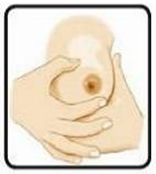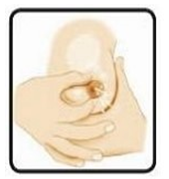- Reference Number: HEY1428/2024
- Departments: Maternity Services
- Last Updated: 30 April 2024
Introduction
This leaflet aims to provide a useful introduction for pregnant women on how to collect and store colostrum in the antenatal period. If after reading this leaflet you still have questions, please speak to your midwife or the infant feeding coordinators, who should be able to answer them.
What is colostrum?
The first milk your body makes is colostrum, which is produced from about 16 weeks of pregnancy, (we would not recommended that you actively express in the antenatal period until 36 weeks of pregnancy). It is usually a golden yellow colour and often very sticky. It is very easy for baby to digest and is therefore the perfect first food for baby. Colostrum is packed full of properties which support your babies health as well as nutrition.
- Colostrum is full of antibodies to protect your baby from infections
- It has a laxative effect, to help baby pass the early stools
- It can reduce the effects of jaundice on your baby
- Giving baby colostrum is a good way to help regulate their blood sugar levels
Colostrum is very concentrated, so a small amount goes a long way.
Why collect colostrum in the antenatal period
Collecting colostrum before your baby is born can be helpful if we think your baby may have challenges with breastfeeding or keeping their blood sugar levels in the early days. This might be because:
- Your baby is likely to be small for their gestational age
- You are expecting twins or triplets
- Your baby has a cleft lip or palate
- They have a heart or other diagnosed condition
- You are diabetic or have developed diabetes in pregnancy
- Are taking beta-blocker medication for raised blood pressure
- You know that you are having a c/section (as breast milk given early may help your baby to adapt to the environment outside the womb easier)
- Have had breast surgery
- You will be required to take medications in the immediate postnatal period which will prevent you from breastfeeding your baby
- You have anticipated or previous problems surrounding milk supply
Whilst we provide antenatal colostrum collecting kits for the above circumstances. It is useful for all mums to learn the skill of hand expression. If you do not fit the above criteria but wish to consider collecting your colostrum in the antenatal period, then we suggest that you purchase suitable syringes on line and follow the advice provided in this leaflet. The syringes that we use are 1 ml (1 mililitre) colostrum collecting syringes with a cap.
Is it safe to collect antenatal colostrum?
Research has shown that antenatal collection of colostrum from 36 weeks carried out as outlined in this leaflet, is likely to be safe for most mothers. However, you should not express antenatal colostrum at home if:
- You are at risk of pre-term labour
- Have a history of pre-term ruptured membranes
- Have a cervical suture in place.
It may however, be appropriate to carry out antenatal colostrum collecting within the hospital environment when labour/birth is imminent.
If you are unsure as to whether it is safe for you to collect antenatal colostrum, we suggest that you speak to your Midwife, Consultant, or the Infant Feeding Coordinators, before commencing.
Some women may experience some abdominal tightening whilst expressing antenatal colostrum known as Braxton Hicks contractions, this is normal.
If however you have any concerns during collecting colostrum you should stop and seek advice from your Midwife.
How to collect antenatal colostrum
The best way to express antenatal colostrum is through hand expressing. It is simple to learn and gets easier with practice. You will only be expressing small amounts of colostrum in the antenatal period, so using a pump will be impractical. Hand expressing allows you to collect the small drops of colostrum in to a syringe so that it can be easily given to baby. The following explains the techniques. You may however also find it useful to watch the video via the QR link below.

- Wash your hands before you begin, with soap and hot water, and dry.
- It may be useful to massage your breasts before you start to express or try expressing after a warm bath or shower.
- Cup your breast in a C shape and place your thumb and fingers about 2 to 3 cm (2 to 3 centimetres) from the base of your nipple.

- Using the C shape use your thumb and forefingers to apply pressure to the breast for approximately 4 to 5 seconds. The pressure should be firm but not painful.
- Release the pressure, then repeat again, and continue to do so in a rhythmic type motion, as if mimicking a baby feeding at the breast.
- Avoid sliding your fingers over your skin as this can cause soreness and may damage your skin.
- Move your fingers around your breast and repeat the process on a different section of your breast.
- You may find moving your fingers slightly towards your nipple or further away may work better for you.
- Small drops of colostrum should begin to appear, this might take practice and several tries.
- These drops of colostrum can be caught in the syringe or if you are struggling to do this, then you can collect them in a sterile container and draw up with the syringe.

When to hand express and how to store the colostrum
We would suggest that you do not actively commence hand expressing your colostrum until around 36 weeks, however if you find that you are leaking colostrum before this time you could collect and store this. You should attempt collection more than twice per day, for around 5 to 15 minutes each time. You should collect in to one syringe per 24 hours. Between collections, you should store the syringe in the main compartment of your fridge, towards the back, as this should keep it at the right temperature for safe storage. You should label the syringe with the date and time of the first collection as well as your name, date of birth and hospital number. If you are collecting at home, you should place your colostrum in the freezer after the second collection of the day.
Bringing your colostrum into hospital
If you are having a hospital birth, you should bring your colostrum syringes in to hospital in a cool type bag, with an ice pack. The colostrum should be kept in the bag with you. Currently we cannot store antenatal colostrum in our hospital fridges and freezers. Any milk defrosted needs to be used within 24 hours. We suggest that you only bring a couple of syringes in with you initially, so as not to waste any milk that defrosts before it is needed. You can have any further syringes brought to the hospital as and when they are required.
If you are being induced
If you are being induced the process of becoming established in labour can take time, so we recommend that you wait to have your milk brought in when your labour is established, again just to make sure none goes to waste. You can however continue to collect your colostrum whilst in hospital during the induction process
Once your baby is born
How and when your antenatal expressed colostrum is used is likely to depend on the reason why you have chosen to collect antenatal colostrum and the Midwives will be on hand to advise and support you with this.
General Advice and Consent
Most of your questions should have been answered by this leaflet, but remember that this is only a starting point for discussion with the healthcare team.
Consent to treatment
Before any doctor, nurse or therapist examines or treats you, they must seek your consent or permission. In order to make a decision, you need to have information from health professionals about the treatment or investigation which is being offered to you. You should always ask them more questions if you do not understand or if you want more information.
The information you receive should be about your condition, the alternatives available to you, and whether it carries risks as well as the benefits. What is important is that your consent is genuine or valid. That means:
- you must be able to give your consent
- you must be given enough information to enable you to make a decision
- you must be acting under your own free will and not under the strong influence of another person
Information about you
We collect and use your information to provide you with care and treatment. As part of your care, information about you will be shared between members of a healthcare team, some of whom you may not meet. Your information may also be used to help train staff, to check the quality of our care, to manage and plan the health service, and to help with research. Wherever possible we use anonymous data.
We may pass on relevant information to other health organisations that provide you with care. All information is treated as strictly confidential and is not given to anyone who does not need it. If you have any concerns please ask your doctor, or the person caring for you.
Under the General Data Protection Regulation and the Data Protection Act 2018 we are responsible for maintaining the confidentiality of any information we hold about you. For further information visit the following page: Confidential Information about You.
If you or your carer needs information about your health and wellbeing and about your care and treatment in a different format, such as large print, braille or audio, due to disability, impairment or sensory loss, please advise a member of staff and this can be arranged.

